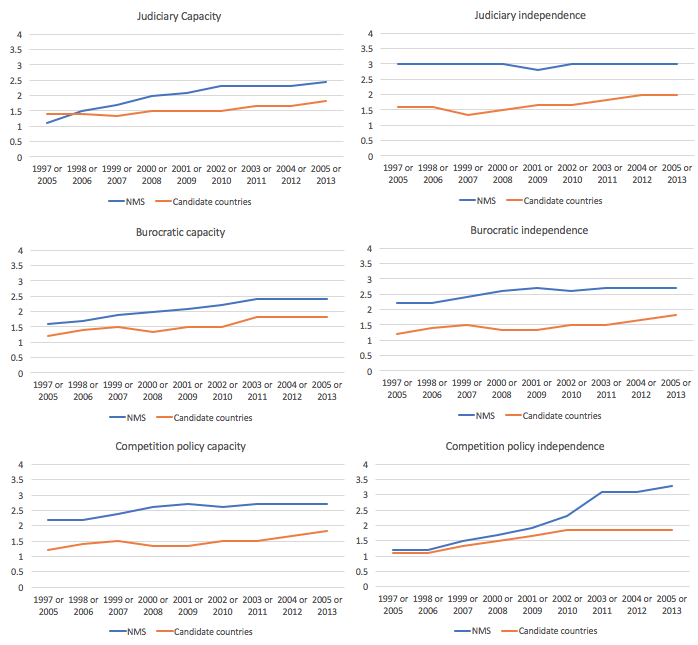The Great Recession and the Eurozone Crisis dented the shared understanding of the economic benefits from EU membership. Economic research has strived to quantify these benefits but many of them have proven notoriously difficult to pinpoint (Crafts 2017).
This column argues that one of these potential benefits is the increase or the build-up of state capacity. We study which role economic integration, specifically the prospect of EU membership, plays in building the capacity of the state to uphold political and economic freedoms, enforce law and order, regulate economic activity, and provide public goods.
By quantifying all progress towards accession reports, we generate a panel of new de jure (independence) and de facto (capacity) institutional measures for 17 EU candidate countries yearly since 1997. They cover the judiciary, bureaucracy, and competition policy and include measures of potential inputs into each of these three areas. Our main finding is the identification of the relationship between judiciary capacity and bureaucratic independence as the key engine of the process of state capacity building engendered by the prospect of EU membership.
The economics of state capacity
According to Besley and Persson (2014), “[T]he lack of attention to the role of state capacity by economists contrasts with other social scientists” (p. 930). The scholarship on state capacity has a long tradition in other social sciences (Tilly 1971, Evans et al. 1985, Geddes 1994). More recently, however, economists have been paying closer attention to the role of institutions. Progress in this area has led to the identification of key individual institutions. It is in this context that the economics literature on state capacity is now fast gaining steam.
The seminal work by Besley and Persson (2009, 2010, 2011) focuses on one key dimension – the capacity of the state to tax. Dinsecco and Katz (2016) and Chuaire et al. (2017) provide further evidence. Moreover, Besley and Persson (2014) investigate complementarities among different state capacities (fiscal, legal, and collective) as well as positive feedbacks between state capacity and income. Acemoglu et al. (2015, 2016) use case studies, such as Colombian inter-governmental relations and diffusion of US post offices, to offer an insightful view into state capacity building. Bardham (2016), Savoia and Ken (2015), and Koyama and Johnson (2017) survey this nascent literature drawing on works from development and history.
Interest is increasing but an important gap remains – we lack sufficiently detailed empirical measures of key state capacity features, comparable across countries and over time.
The yearly reports on progress towards accession of the European Commission offer an exceptional basis for such analysis. From 1997 onwards, the EU implemented a system of regular standardised monitoring of progress in institutional building, covering all the arenas that could affect the capacity of candidate countries to implement the rules of the Single Market. These roughly correspond to the various individual chapters of the acquis. Quantifying these reports generates a longitudinal database that reflects changes in key institutional areas (Bruszt and Campos 2017). The reports detail the national paths in meeting the institutional requirements of EU membership from the transplantation of regulations (Berkowitz et al. 2003) to the creation of regulatory organisations endowed with necessary powers, resources, and personnel.
Mechanisms: How does integration build up state capacity?
Figure 1 shows the unweighted yearly averages of our measures of the capacity and independence of the judiciary, of the bureaucracy, and of competition policy for all (post 1995) 17 EU candidate countries.1
These are categorical variables taking values between 1 and 4, with 4 indicating levels of institutional development comparable to those in EU Member States, 3 for satisfactory levels but still in need of minor improvements, 2 for progress below the minimum level of EU requirements, and 1 reflecting severe deficiencies in moving towards EU norms.
In Figure 1 we divide the sample in those countries that have joined the EU (New Member States) and those that haven’t (Candidate Countries.) For most of the former, data are available yearly between 1997 and 2005, while for the latter between 2005 and 2013. Figure 1 exploits these common nine-year windows plotting the New Member States series over 1997-2005 and Candidates over 2005-2013.
First note that, on average, neither the New Member States group nor the Candidate group has fully satisfied EU requirements in any of the six areas shown. By the end of the period, only competition policy independence and judiciary capacity and independence for the New Member States group are at or above satisfactory convergence levels.
It is also worth noting that there is surprisingly little difference between New Member States and Candidates at the outset (1997 for NMS and 2005 for Candidates). There is even one area (judiciary capacity) in which Candidates average score is sightly higher than New Member States.
Figure 1 Building up state capacity from prospective EU membership
Notes: De Jure and De Facto Dimensions of the Judiciary, Bureaucracy and Competition Policy. Yearly Averages for New Member States (1997-2005) and Candidate Countries (2005-2013).
Source: Bruszt and Campos (2017)
Finally, there seems to be plentiful evidence of a powerful ‘EU pull’ factor (Berglof and Roland 1997). Although final levels tend to be higher for de jure (independence) than for de facto (capacity) dimensions, there has been a very strong EU pull in judiciary capacity and competition policy independence in one extreme, almost no pull in judiciary independence in the other, and a strong EU pull in the remaining three areas. Recall these changes happened over nine years, not nine decades.
Sequencing ‘R’ Us
We argue that the relationships between inputs into and among the institutional outcomes of the bureaucracy, judiciary, and competition policy build-up can be understood as reform implementation sequences (Bruszt and Campos 2017).
Starting from the quality of bureaucracy, we uncover evidence that civil servants’ training and civil service law in the current period positively affect bureaucratic capacity in the next period, which in turn positively affects bureaucratic independence one-year ahead.
Turning to the judiciary, the only input we uncover driving capacity is the courts’ workload, idem effectiveness of the Supreme Court vis-à-vis judiciary independence. We also find that without judicial oversight, there is no guarantee that supervisory agencies can monitor and enforce market competition rules effectively.
Our most important finding, however, rests upon the relationship between judiciary capacity and bureaucratic independence. We estimate that capable courts are prime movers behind the development of an independent state bureaucracy, and vice-versa. Judiciary capacity in the previous year is positively correlated with bureaucratic independence in the current year. And uniquely among our results (i.e. this is the only positive feedback we find), bureaucratic independence in the last period is related to judiciary capacity in the current year.
Two additional results are noteworthy. First, these institutional reforms have economic implications. For example, we find that a strong Supreme Court and a capable judiciary are positively correlated with per capita income, while countries with higher export to GDP ratios tend to show more competition policy capacity. Competition policy capacity is also positively correlated with the income share of the poorest 10% of the population as with labour income share (the latter results are similar for judiciary independence).
Second, we find that correlations between our measures (either de facto or de jure) and other widely used institutional variables (such as Freedom House, Polity, and executive constraints) are substantially higher than the correlations between these widely used measures and our inputs. This raises the possibility that there may be an overabundance of measures of institutional outcomes, without similar availability of measures of ‘inputs’ into these. Or, to put it bluntly, we may have reached a wealth of measures of the same thing (‘outcomes’) but a dearth remains of indices capturing factors that may play a role in driving these outcomes (‘inputs’).
Conclusions: Visegrad and Brexit alert
This column introduces a new set of measures that helps to document whether and how economic integration contributes to increases in state capacity. We uncover various implementation sequences that depict the evolution of three important institutional areas across countries and over time. Our main finding regards the identification of the intricate relationship between bureaucratic independence and judiciary capacity as possibly the main driver of the process of state capacity-building engendered by the prospect of EU membership.
In stressing the importance of deep integration for building up state capacity, our results prompt two concerns. We worry that, in the future, Brexit may show that decoupling can have the opposite effects, namely that disintegration leads to imploding state capabilities. The evidence on display by political elites since the Brexit referendum does little to placate our concerns. Secondly, we worry that the recent developments in new member states such as Poland and Hungary will turn into painful reminders that it is a mistake to think these institutional and economic development gains are irreversible and do not require purposeful monitoring, post accession.
References
Acemoglu, D, C García-Jimeno and J Robinson (2015), “State capacity and economic development: A network approach”, American Economic Review 105(8): 2364–2409.
Acemoglu, D, J Moscona and J Robinson (2016), “State capacity and American technology: Evidence from the nineteenth century”, American Economic Review 106(5): 61-67.
Bardhan, P (2016), “State and development: The need for a reappraisal of the current literature”, Journal of Economic Literature 54(3): 862-892.
Berkowitz, D, K Pistor and J Richard (2003), “Economic development, legality, and the transplant effect”, European Economic Review 47(1):165-195.
Berglöf, E and G Roland (1997), “The EU as an ‘outside anchor’ for transition reforms,” in A Bigger and Better Europe? Final Report to the Swedish Government from the Committee on the Economic Effects of EU Enlargement, Fritzes Stockholm: 77-94.
Besley, T and T Persson (2009), “The origins of state capacity: Property rights, taxation, and politics”, American Economic Review 99(4): 1218–44.
Besley, T and T Persson (2010), “State capacity, conflict and development”, Econometrica 78 (1): 1–34.
Besley, T and T Persson (2014), “The causes and consequences of development clusters: State capacity, peace and income”, Annual Review of Economics 6: 927–948.
Bruszt, L and N Campos (2017), “State capacity and economic integration: Evidence from the EU eastern enlargement”, EUI Schuman Center, WP 2017/52.
Chuaire M, C Scartascini and M Tommasi (2017), “State capacity and the quality of policies: Revisiting the relationship between openness and government size”, Economics & Politics 29(2): 133–156.
Crafts, N (2017), “UK economic growth performance in a European context: Has EU membership made much difference?” in N Campos and F Coricelli (eds), The Economics of UK-EU Relations: From the Treaty of Rome to the Vote for Brexit, Palgrave MacMillan: 9-45.
Dincecco M and G Katz (2016), “State capacity and long-run economic performance”, Economic Journal 126(590): 189–218.
Evans, P, D Rueschemeyer and T Skocpol (1985), Bringing the State Back In, Cambridge: Cambridge University Press.
Johnson, N and M Koyama (2017), “States and economic growth: Capacity and constraints”, Explorations in Economic History, 64(1): 1-20.
Savoia, A, and K Sen (2015), “Measurement, evolution, determinants, and consequences of state capacity: A review of recent research”, Journal of Economic Surveys 29(3): 441-458.
Tilly, C (1975), “Reflections on the history of European state-making”, in Tilly, C (ed) The Formation of Nation-States in Western Europe. Princeton, Princeton University Press.
Endnotes
[1] Our sample contains these countries (followed by the years of the progress reports we use): Albania 2005-2013; Bosnia 2005-2013; Bulgaria 1997-2006; Croatia 2005-2013; Czech Rep 1997-2003; Estonia 1997-2003; Hungary 1997-2003; Kosovo 2005-2013; Latvia 1997-2003; Lithuania 1997-2003; Macedonia 2007-2013; Montenegro 2007-2013; Poland 1997-2003; Romania 1997-2006; Serbia 2005-2013; Slovakia 1997-2003; Slovenia 1997-2003; and Turkey 1998-2013.




